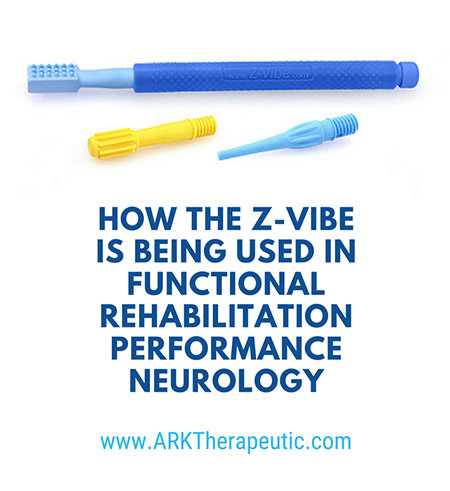How the Z-Vibe Is Being Used In Functional Rehabilitation Performance Neurology
17th Aug 2018
Back in 2000, we originally conceived the
Z-Vibe as a speech therapy tool - a device that would provide sensory input to the mouth via vibration and tactile cues. Since then, the Z-Vibe has become more versatile than we ever imagined 18 years ago. We use it for everything from normalizing oral sensitivities to feeding therapy to writing skills and much more.
.
One of the things we find especially exciting, however, is when other people discover new ways to use our products. Last year, for example, we learned that some people are using the Z-Vibe to improve their
singing skills. Most recently, we had the pleasure of learning about how a company called Z-Health is using the Z-Vibe for rehabilitation and neurology applications.
.
With about 3,000 trainers worldwide, Z-Health Performance is an educational company that uses functional neurology for pain relief, rehabilitation of chronic neurologic disorders, sports performance, and everything in between. In other words, they focus on using the nervous system to rehabilitate and "debug" movement patterns.

.
The nervous system does three major things: It receives input from the external and internal environment, then it interprets that input and decides what needs to happen, and finally it creates some kind of motor output(s) to enact our will in the world. So input, interpret/decide, and output.
.
Z-Health training gives equal weighting to all three areas. Rather than only focusing on outputs (e.g. “my shoulder hurts”), they also focus on what kinds of input cause that output (i.e. what kind of input leads to an output of shoulder pain), as well as which areas of the brain integrate and process that input. The end goal is to create a better output by changing the input and/or how that input is interpreted.
.
In looking for new and innovative ways to do this, one area they’ve been studying is the influence of mouth and tongue mechanics and sensation on overall brain function. Which is where the Z-Vibe comes in! To that end, they use the Z-Vibe:
.
- For sensation testing and vibratory stimulus to activate different areas of the brain (brain stem, frontal cortex, etc.) that may be dysfunctional.
- To help drive more constant neuroplastic activity in the brain. More and more, they’re seeing that tongue and jaw positioning directly influences motor activity in the rest of the body (the facial muscles, diaphragm, pelvic floor, etc.)
- For basic sensation drills - They start off using the different tip attachments (especially the Probe, Preefer, and Fine Tips) to give patients an opportunity to explore the different portions of the mouth. Z-Health has found that working with the different tips can be very useful particularly if the individual has some kind of long-term disturbance in sensation. The opportunity to have different textures along with vibration allows them to provide even higher levels of stimulus to the brainstem into the cortex.
- In the field of neuromodulation (neuromodulation looks at how to influence brain activity using different receptor inputs). As Dr. Cobb explains in the video below, “One of the things that has come out of the research in general is that we can drive greater neuroplastic change in a patient’s brain by providing a stimulus that is both novel and challenging at the same time. And a lot of the work that has been done in neuroplastic rehabilitation uses the tongue in particular as a vehicle to give novel sensory input into the brainstem and the cortex. So, the simple vibrating component of the Z-Vibe we have found to be incredibly important whenever we’re trying to create neuroplastic change in our clients.”
- To pair with other stimuli. Dr. Cobb also explains, “When you look at dysfunctional brains, one of the biggest challenges is an area that has been dysfunctional for a long period of time may not respond to only one form of stimulus. So let’s say I have lost sensation in my left hand, and you’re trying to create stimulus in my right parietal lobe. If this area has been dysfunctional for a really prolonged period - then simply stimulating my left hand may not ever drive plastic change to that right parietal lobe. So we often will pair the Z-Vibe with some kind of other stimulus. [For example,] I can give you a visual drill or some kind of other stimulus to be performed at the same time that we are giving you sensation in the hand, and usually the pairing of the correct forms of stimulus actually creates greater brain plasticity, and that to me is one of the huge values of how we use the Z-Vibe in the work that we do.”
- For use not just in the mouth, but in the extremities as well. “Let’s say a client has a scar that needs some level of stimulus applied - we’ll often test it with the high Hertz vibration [from the Z-Vibe], and so again this is a really great tool for people to use not just on the mouth but in other areas of the body that need sensory work. Let’s say I’ve got all these issues in my left arm, and a scar that needs vibratory stimulus - we may have the client doing motor control exercises at the same time they’re applying the vibratory stimulus (again using that same idea of creating stacked input into different areas of the brain that are really asking for it). So like I said - a really great tool.” - Dr. Cobb
- To vibrate the teeth. “One of the cool studies that came out of a dental school about five years ago was what happens whenever we vibrate the teeth. Because the teeth are innervated by the trigeminal nerve, when we give vibratory stimulus to the teeth (particularly the front teeth) biting down on the Z-Vibe, that actually activates the supplementary motor area which is in the frontal lobe. The supplementary motor area is highly involved in bilateral midline stability, and so when we see kids that have very poor midline stability - maybe they’re overly flexible or they’re inflexible but lack strength, they lack coordination. They have movement deficits in the arms and legs. Because they lack that midline stability, very often we will find that stacking the Z-Vibe stimulus on the teeth to activate the supplementary motor area — along with some vision exercises and some proprioceptive drills — often creates a huge burst of input to create longstanding change for them.” - Dr. Cobb
.
A big thanks to Dr. Eric Cobb and Z-Health for sharing this very interesting information with us! They’ve been using the Z-Vibe for about four years now. Please find the full video below:
.
.
To learn more about Z-Health and what they do, and/or to find a Z-Health trainer, visit: www.zhealtheducation.com. Z-Health has about 3,000 trainers worldwide.
Further reading (books) recommended by Dr. Cobb:
Therapeutic Neuroscience Education
Explain Pain Supercharged
The Brain’s Way of Healing
.

